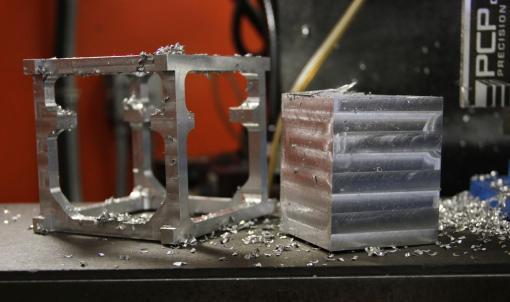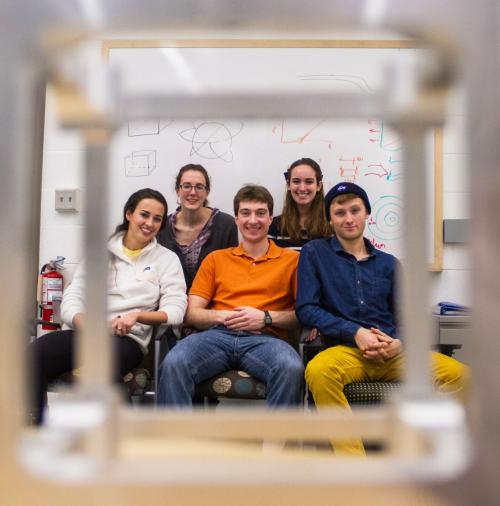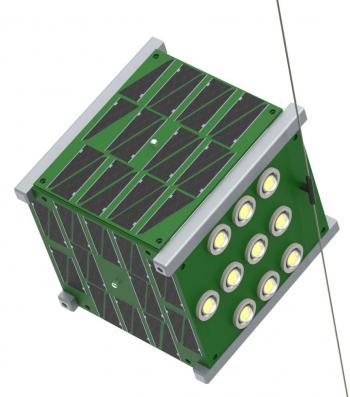
The fully functional EQUiSat package — solar panels, LED beacon, control and communications gear, batteries — will fit into this four-inch cube. Building the satellite from scratch will keep the project’s cost to around $13,000.
PROVIDENCE, R.I. [Brown University] — EQUiSat, a nanosatellite being built by a team of Brown University students, has been cleared for launch.
NASA announced last week that EQUiSat is among 16 small satellites selected to fly on rockets to be launched over the next three years. EQUiSat has not been assigned to a particular rocket, but the announcement assures that the student-led project has a ticket to ride.
"It was pretty great to hear the news on Thursday," said Hannah Varner, a senior engineering concentrator and one of the team's leaders. "We've all been in disbelief for the last few days."
The launch will be part of NASA's CubeSats Launch Initiative. CubeSats are miniature spacecraft — four-inch cubes weighing around two pounds — that can be included as auxiliary payloads on rockets flown for other primary missions. The program's purpose is to spur innovation in the design of relatively low-cost satellites and to get students interested in space technology. To get into the program, the Brown team submitted an application and made presentations to two review boards that judged the project's technical feasibility and overall merit.

Not a lot of money, not a lot of time: Four years to design, build, and test plus a three-year launch window could make EQUiSat a seven-year project. The team trains successive classes to carry the project forward: “We have a really enthusiastic bunch coming up behind us."
EQUiSat's mission will be largely educational. The tiny satellite will carry a flashing LED beacon that will be visible to the naked eye as it passes through the night sky. In Providence, the beacon should be approximately as bright as the North Star, flashing every two minutes when in the night sky. EQUiSat will also broadcast via radio data on the health of its systems and its orientation relative to the Earth and sun. The signal will be available to anyone with a simple amateur radio receiver.
The idea is for EQUiSat to be a visible and audible ambassador from space to students and space enthusiasts on earth. The Brown team plans to combine the launch with a public outreach program. An app will help people track EQUiSat and know when it's visible at their location. The team also plans to put together lessons that use EQUiSat to teach middle and high school students about satellites, orbital science, and space in general.
"Satellites have become so common but so few people know how important they are to everything we do," Varner said. "They're crucial to cell phones and TV and everything. So exposing a younger audience and a non-science audience to satellites was important for us."
Another aspect of the mission is to show that space can be accessible to just about anyone with enough interest to try to get there.
"CubeSats are a really great architecture because, compared to other kinds of satellites, you can build them really quickly and get a launch comparatively easily," said Emily Gilbert, a physics concentrator and an EQUiSat team leader. "They're launched as secondary payloads so you don't need to commission your own rocket for hundreds of millions of dollars. So it's great for student groups without a lot of money and without a lot of time."

EQUiSat: Solar arrays will charge the battery that aligns the satellite, powers its LED beacon, and sends radio messages about the health of its systems.
EQUiSat will be inexpensive even by CubeSat standards. The students are building their satellite essentially from scratch, despite the fact that CubeSat parts — chassis, solar panels, and other components — can be purchased. Those parts aren't cheap, and the build cost for most CubeSats is generally north of $30,000. But the EQUiSat team is working on a budget of around $13,000. Ultimately the students hope the design they develop for EQUiSat will lead to a CubeSat that can be built for $3,000 or less.
"We're trying to prove that it's possible to meet all of the specifications and all of the requirements without the very, very costly technology that is out there to build a satellite," Varner said.
The students have worked for the last three years to design and build EQUiSat's key systems. An attitude control system will align the satellite with Earth's magnetic field to keep the LED pointed at a visible angle. A solar array will charge a set of lithium iron phosphate batteries, which will in turn power the LED and radio communications system. All of those systems will be carried on a chassis that can withstand the vibration of launch and the harsh vacuum of space. The team will spend the next year or so refining those systems and putting them all together on their tiny spacecraft.
The EQUiSat venture was launched in 2011 as part of an engineering design class taught by Rick Fleeter, adjunct professor of engineering. The project morphed into a student club in 2012 and now has around 30 student members. Fleeter, who founded a private satellite company before coming to Brown, oversees the club. But this is very much a student-owned project, he says.
"They're just going on their own energy. I kind of got them pointed in the right direction, but it's not like I have to encourage them or say, 'Gee, guys, we ought to have a meeting.' They just go."
The original student founders were Kelsey MacMillan, Alexander Neff, Alexander Carrere, and Michael Monn, all members of the 2012 class. They passed the torch to the current group of leaders, including Varner, Gilbert, Kelly Hering, Tyler Del Sesto and Casey Meehan. All except Meehan are seniors, so they'll need to pass the torch again. They're quite confident that younger students will get EQUiSat into space.
"We have a really enthusiastic bunch coming up behind us," Gilbert said. "We have a lot of faith in them."
The team could get its launch call anytime starting next year through 2017.
- by Kevin Stacey